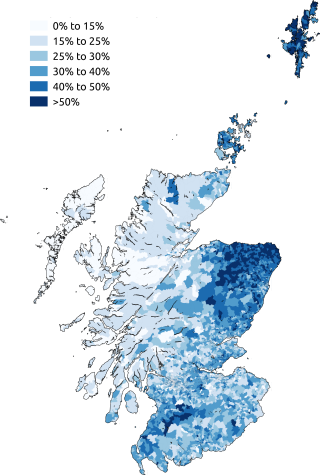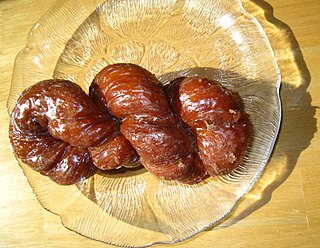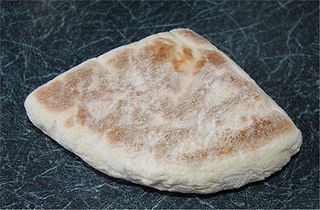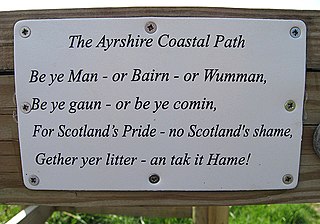Related Research Articles

Hogmanay is the Scots word for the last day of the old year and is synonymous with the celebration of the New Year in the Scottish manner. It is normally followed by further celebration on the morning of New Year's Day and in some cases, 2 January—a Scottish bank holiday.

Doric, the popular name for Mid Northern Scots or Northeast Scots, refers to the Scots language as spoken in the northeast of Scotland. There is an extensive body of literature, mostly poetry, ballads, and songs, written in Doric. In some literary works, Doric is used as the language of conversation while the rest of the work is in Lallans Scots or British English. A number of 20th and 21st century poets have written poetry in the Doric dialect.

Scots is an Anglic language variety in the West Germanic language family, spoken in Scotland and parts of Ulster in the north of Ireland. Most commonly spoken in the Scottish Lowlands, Northern Isles and northern Ulster, it is sometimes called Lowland Scots or Broad Scots to distinguish it from Scottish Gaelic, the Goidelic Celtic language that was historically restricted to most of the Scottish Highlands, the Hebrides and Galloway after the sixteenth century. Modern Scots is a sister language of Modern English, as the two diverged independently from the same source: Early Middle English (1150–1300).

Ulster Scots or Ulster-Scots, also known as Ulster Scotch and Ullans, is the dialect of Scots spoken in parts of Ulster in Northern Ireland and the Republic of Ireland. It is generally considered a dialect or group of dialects of Scots, although groups such as the Ulster-Scots Language Society and Ulster-Scots Academy consider it a language in its own right, and the Ulster-Scots Agency and former Department of Culture, Arts and Leisure have used the term Ulster-Scots language.
Scottish English is the set of varieties of the English language spoken in Scotland. The transregional, standardised variety is called Scottish Standard English or Standard Scottish English (SSE). Scottish Standard English may be defined as "the characteristic speech of the professional class [in Scotland] and the accepted norm in schools". IETF language tag for "Scottish Standard English" is en-scotland.

Shortbread or shortie is a traditional Scottish biscuit usually made from one part white sugar, two parts butter, and three to four parts plain wheat flour. Unlike many other biscuits and baked goods, shortbread does not contain any leavening, such as baking powder or baking soda. Shortbread is widely associated with Christmas and Hogmanay festivities in Scotland, and some Scottish brands are exported around the world.

A cruller is a deep-fried pastry like a doughnut popular in Europe and North America often made from a rectangle of dough with a cut made in the middle that allows it to be pulled over and through itself, producing twists in the sides of the pastry. The cruller has been described as resembling "a small, braided torpedo". Some other cruller styles are made of a denser dough somewhat like that of a cake doughnut formed in a small loaf or stick shape, but not always twisted. Crullers may be topped with powdered sugar or icing.

A farl is any of various quadrant-shaped flatbreads and cakes, traditionally made by cutting a round into four pieces. In Ulster, the term generally refers to soda bread and, less commonly, potato bread, which are also ingredients of an Ulster fry.

Tablet is a medium-hard, sugary confection from Scotland. Tablet is usually made from sugar, condensed milk, and butter, which is boiled to a soft-ball stage and allowed to crystallise. It is often flavoured with vanilla and sometimes has nut pieces in it.
Craic or crack is a term for news, gossip, fun, entertainment, and enjoyable conversation, particularly prominent in Ireland. It is often used with the definite article – the craic – as in the expression "What's the craic?". The word has an unusual history; the Scots and English crack was borrowed into Irish as craic in the mid-20th century and the Irish spelling was then reborrowed into English. Under either spelling, the term has attracted popularity and significance in Ireland.

Stovies is a Scottish dish based on potatoes. Recipes and ingredients vary widely but the dish contains potatoes, fat, usually onions and often pieces of meat. In some versions, other vegetables may also be added.
The 'apologetic' or parochial apostrophe is the distinctive use of apostrophes in Modern Scots orthography. Apologetic apostrophes generally occurred where a consonant exists in the Standard English cognate, as in a' (all), gi'e (give) and wi' (with).

Shetland dialect is a dialect of Insular Scots spoken in Shetland, an archipelago to the north of mainland Scotland. It is derived from the Scots dialects brought to Shetland from the end of the fifteenth century by Lowland Scots, mainly from Fife and Lothian, with a degree of Norse influence from the Norn language, which is an extinct North Germanic language spoken on the islands until the late 18th century.
Central Scots is a group of dialects of Scots.

Scottish cuisine encompasses the cooking styles, traditions and recipes associated with Scotland. It has distinctive attributes and recipes of its own, but also shares much with British and wider European cuisine as a result of local, regional, and continental influences—both ancient and modern.
A Scotticism is a phrase or word which is characteristic of dialects of the Scots language.

Clapshot is a traditional Scottish dish that originated in Orkney and may be served with haggis, oatcakes, mince, sausages or cold meat. It is created by the combined mashing of swede turnips and potatoes with the addition of chives, butter or dripping, salt and pepper; some versions include onions. The name is Orcadian in origin.
Sowans or sowens, also called virpa in Shetland, is a Scottish dish made using the starch remaining on the inner husks of oats after milling. The husks are allowed to soak in water and ferment for a few days. The liquor is strained off and allowed to stand for a day to allow the starchy matter therein to settle. The liquid part, or swats, is poured off and can be drunk. The remaining sowans are boiled with water and salt until thickened, then served with butter or dipped into milk. The flavour is distinctly sour.

Modern Scots comprises the varieties of Scots traditionally spoken in Lowland Scotland and parts of Ulster, from 1700.
Powsowdie is a Scottish sheep's-head broth or soup. Traditional preparation of the soup includes sheep's trotters as an ingredient. Dried peas and barley can also be used as additional ingredients. Powsowdie has been described as a speciality dish in Edinburgh, Scotland. Powsowdie is less popular and less known in contemporary times; it was more prominent during times when "all parts of an animal were used in cooking and nothing was wasted". The National Library of Scotland included powsowdie in a 2015 food history exhibition named "Lifting the lid", which was an exhibit of historic Scottish recipe books that included example dishes.
References
- 1 2 S.W.R.I. (1977). S.W.R.I. Jubilee Cookery Book. Edinburgh: Scottish Women's Rural Institutes; Reprint of 8th Edition (1968), p136
- ↑ "Dictionary of the Scots Language:: SND :: Kit n1 V".
- ↑ "Dictionary of the Scots Language:: SND :: Hat n v1".
- 1 2 McNeill, F. Marian (1929). The Scots Kitchen. Paperback: 259 pages, Edinburgh: Mercat Press; New Edition (25 Oct 2004) ISBN 1-84183-070-4, p208-9
- ↑ https://www.pressreader.com/uk/scottish-field/20160401/282570197189760 – via PressReader.
{{cite web}}: Missing or empty|title=(help) - ↑ "Hatted Kit from Farmhouse Kitchen by Audrey Ellis".